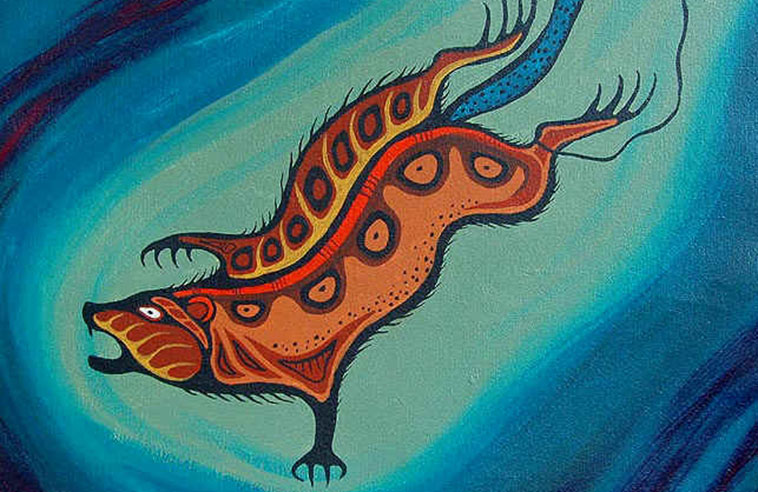
MUSKRAT is an online Indigenous arts and culture magazine that honours the connection between humans and our traditional ecological knowledge by exhibiting original works and critical commentary. MUSKRAT embraces both rural and urban settings and uses media arts, the Internet, and wireless technology to investigate and disseminate traditional knowledges in ways that inspire their reclamation.
Our Team

Rebeka Tabobondung
Publisher & Editor-in-Chief
Editor of MUSKRAT Magazine, Rebeka Tabobondung is a community documentary filmmaker, poet and Indigenous knowledge researcher. Rebeka is an M.A. graduate in Sociology & Equity Studies in Education. Her documentary work has screened at festivals across Canada and internationally, while her written works have been published in numerous journals and anthologies throughout North America. In 2008, Rebeka was the Festival Director of the imagineNATIVE film & Media Arts Festival and was also the former Director of the Centre for Women and Trans People at the University of Toronto. Rebeka’s latest research and film work documents traditional birth knowledge from Wasauksing First Nation where she is also a member. She is the co-founder of MAAIINGAN Productions and Research Coordinator of the Indigenous Knowledge Network for Infant, Child, and Family Health at St. Michael’s Hospital.

David Shilling
Creative Director
With over twenty years of graphic and web design experience, David Shilling is the founder of the award winning visual communications company, MAAIINGAN Productions and the Creative Director and co-founder of MUSKRAT Magazine. Throughout his career David has successfully managed and delivered thousands of design projects and brings a wide range of design experience collaborating within both Indigenous and non-Indigenous communities using multiple medias.
David brings large-scale project management skills such as establishing the premiere issue of First Nations House Magazine (print and online publications) to executing smaller scale design projects such as logo and poster design. David’s design works can be found in MUSKRAT Magazine, Indigenous Arts Journal, Spirit Magazine, Red Wire Magazine, XEROX Canada, Royal Bank of Canada, and Aboriginal Voices Magazine. David has designed websites for Canada’s leading Aboriginal organizations including: ImagineNative Film + Media Arts Festival, Chiefs of Ontario, First Nations House at The University of Toronto, and Seventh Generation Midwives Toronto.
David Shilling was raised in Rama and Tyendinaga First Nations and in the city of Toronto. As well as being self-taught, Dave has studied graphic and web design at George Brown College and Ryerson University.

Shannon Webb-Campbell
Associate Editor & Staff Writer
Shannon Webb-Campbell is of Mi’kmaq and settler heritage. She is a member of Flat Bay First Nation. Her books include: the forthcoming Re: Wild Her (Book*hug 2025), Lunar Tides (2022), I Am a Body of Land (2019), and Still No Word (2015), which was the recipient of Egale Canada’s Out in Print Award. Shannon is a PhD candidate at the University of New Brunswick, and the editor of Visual Arts News Magazine.

Aimee Rochard
Online Content Coordinator
Aimee is the online content coordinator and graphic designer for MUSKRAT Magazine. She is a first generation Canadian with Indigenous roots in the Caribbean. Aimee lives and works in Toronto and enjoys playing with shapes and colours.
TEACHINGS FROM THE MUSKRAT

Painting by: Carl Ray (1943 – 1979)
The Muskrat (Wa-zhushk) of the Anishinabe Re-Creation story is an easily relatable character. Although there are perhaps as many variations of the story as there are storytellers sharing it, the Muskrat as a central figure remains the same. In the version re-told by Anishnabe storyteller Basil Johnston in his work Ojibway Heritage, there has been a great flood and most life on Earth has perished, with the exception of birds and water creatures. Sky-Woman survives and comes to rest on the back of a great turtle. She asks the water creatures to bring her soil from the bottom of the waters so that she may use it to make new land. The water animals (the beaver, the marten, the loon) all try to help her and fail. Finally, Muskrat volunteers, much to the scorn of the others. Though ridiculed, Muskrat, the most humble of the water creatures, is determined to help. So he dives down while the animals and sky-woman wait.
“They waited for the muskrat to emerge as empty handed as they had done. Time passed. Smiles turned to worried frowns. The small hope that each had nurtured for the success of the muskrat turned into despair. When the waiting creatures had given up, the muskrat floated to the surface more dead than alive, but he clutched in his paws a small morsel of soil.” Basil Johnston
When I shared this story with my ten-year-old son, Arden, he astutely observed, “ if Muskrat didn’t make his sacrifice, we would not be here”.
In such a sacrifice there is renewal, re-birth and transformation. Through this story, the act itself takes on a new meaning. We tend to think of sacrifice as something undesirable, but in the Re-Creation story, it is necessary and honourable in order for Creation to continue. Muskrat is given special gifts from the Creator for his sacrifice. Elder Benton Banai tells us about the Muskrat’s gifts bestowed by the Creator for his sacrifice in the Mishomis Book: The Voice of the Ojibway.
“No matter that marshes have been drained and their homes destroyed in the name of progress, the muskrats continue to grow and multiply. The Creator has made it so muskrats will always be with us because of the sacrifice that our little brother made for all of us many years ago when the Earth was covered with water.”
In this light, Anishinabe people are very much like the muskrat. We continue to flourish despite the despair brought on by colonization, and like Muskrat, we are still willing to teach and help others. Muskrat is not trying to be a hero, to be better than anyone else; he just wants to help. He is motivated by love for Creation and compassion for Sky-Woman, not by the idea of making a name for himself. The muskrat is a powerful symbol and a reminder of our ability to adapt and transform in order to meet ever-changing challenges and demands. The muskrat is also a reminder that sometimes tasks that seem insurmountable can be achieved with strength and the ability to believe in what’s possible.
Muskrat of the Re-Creation story also embodies values from the teachings of the Seven Grandfathers. Muskrat is brave and kind; despite the grave danger involved in attempting the feat, he has the courage to try. Muskrat is also the humblest of the water creatures, and despite the ridicule of the other creatures, he is determined to help. From the muskrat we learn humility- that we are no better than any other being of Creation, but that we should offer what gifts we have in order to ensure Creation continues.
In our discussion about the story Arden pointed out another truth: despite their greater size and strength, the other water creatures failed to bring the soil to the surface. Yet when Muskrat volunteers to help, the other creatures scoff. Despite being the humblest of the water creatures, the muskrat was able to “deliver the goods” so to speak. It is thus not for us to judge the merits of another, instead, it is important for us to respect and honour all beings and creatures of Creation. “Where the great had failed, the small succeeded” Johnston points out. Muskrat teaches us about ethical conduct, the action necessary to ensure that Creation continues. Muskrat informs us about our relationships with each other and with the natural world, including teachings about cooperation, respect, honour, humility, bravery, love and sacrifice. Anishinabe knowledge is fundamentally about relationships drawn from these values and shared in our stories.
Interestingly, the Re-Creation embodies not only ethical and moral values around conduct and ways of relating, but ecological knowledge as well. It is ironic to learn what today’s scientists have discovered about the muskrat’s biology: that it has the ability to dive down in the water for up to 15 minutes, that it can relax its body, lower its heart rate and reduce its need for oxygen; very few mammals can do this. The Anishinabe already knew this biology and also understood the creatures’ ecology.
In summary, the heroic feat of the humble muskrat in the Re-Creation story conveys the values, teachings, principles and knowledge (ethical, moral and ecological) that form the basis of Anishinabe environmental knowledge. Muskrat’s example reminds us of our responsibilities to ensure the continuance of Creation. It is through fulfilling these responsibilities and giving life to these teachings that we can truly unlock our potential and transcend our original capabilities.
Anishinabe, as conveyed through the teachings of Muskrat have a responsibility to share our wisdom and celebrate our truths, even if the task seems daunting. The Muskrat reminds us to be open to the creative possibilities of living in balance with Creation.




